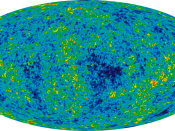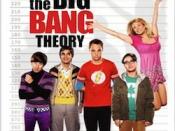The Big Bang is today accepted as the ground theory of how our universe was created. The theory is that our universe was created about 13.7 billion years ago from a very compact and energetic state and then grows to the size it is right now and continues to grow in the future. It is just like a balloon; it gets bigger and bigger the more air you blow into it, but it is only the space between all the stars and planets that is expanding. The evidence for the expansion is the red shift, cosmic background radiation and the way that helium and hydrogen are scattered in the universe.
Distant galaxies send a spectrum of light dislocated towards the red part, which can be interpreted that the universe is expanding and this is called red shift.
From every direction of the universe there is a heat radiation that does not vary very much from one direction to another.
This is called cosmic background radiation and is suppose to originate from the Big Bang.
Helium and hydrogen can not be produced in the stars in any way so that the elements are as scattered and as common as they are according to all the observations.
You can divide the Big Bang theory into nine phases. The first of these phases, phase 1 is the first 10-43 seconds, the so called "Planck time". About this phase we can not say anything.
In phase two the temperature is very high, 1032 Kelvin. (The zero point of the Kelvin scale is equivalent to -273.16 ðC. This zero point is the lowest possible temperature of anything in the universe. At the freezing point of water, the temperature of the Kelvin scale reads 273 K, at the boiling point of water, it reads 373 K.


![Comparison of the predictions of the standard Big Bang model with experimental measurements. The power spectrum of the cosmic microwave background radiation anisotropy is plotted in terms of the angular scale (or multipole moment) (top).]]](https://s.writework.com/uploads/4/49037/comparison-predictions-standard-big-bang-model-experimental-thumb.jpg)